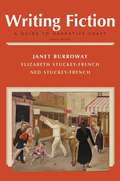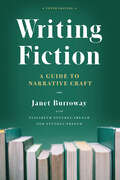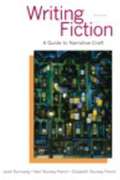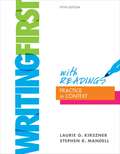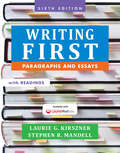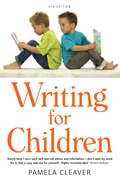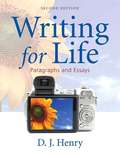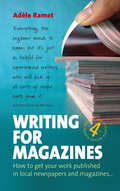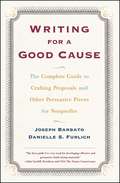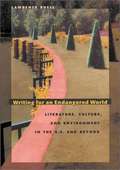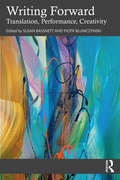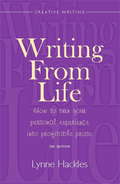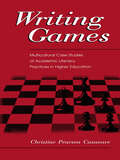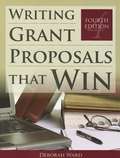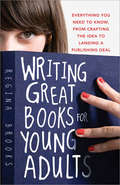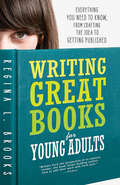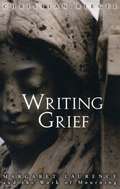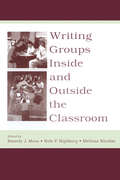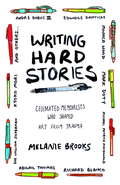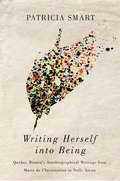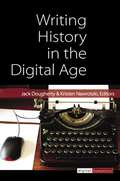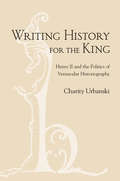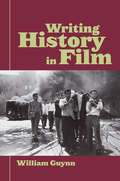- Table View
- List View
Writing Fiction: A Guide to Narrative Craft (8th Edition)
by Janet Burroway Elizabeth Stuckey-French Ned Stuckey-French'Writing Fiction' explores the elements of fiction, providing practical writing techniques and examples. This book encourages students to develop proficiency through each step of the writing process. It also integrates diverse, contemporary short stories in every chapter.
Writing Fiction: A Guide to Narrative Craft (Chicago Guides to Writing, Editing, and Publishing)
by Janet Burroway Elizabeth Stuckey-French Ned Stuckey-FrenchThis updated edition of the classic, comprehensive guide to creative writing features new topics and writing prompts, contemporary examples, and more.A creative writer’s shelf should hold at least three essential books: a dictionary, a style guide, and Janet Burroway’s Writing Fiction. This best-selling classic is the most widely used creative writing text in America, and for decades it has helped hundreds of thousands of students learn the craft. Now in its tenth edition, Writing Fiction is more accessible than ever for writers of all levels—inside or outside the classroom.This new edition continues to provide advice that is practical, comprehensive, and flexible. Moving from freewriting to final revision, Burroway addresses “showing not telling,” characterization, dialogue, atmosphere, plot, imagery, and point of view. It includes new topics and writing prompts, and each chapter now ends with a list of recommended readings that exemplify the craft elements discussed. Plus, examples and quotations throughout the book feature a wide range of today’s best and best-known creators of both novels and short stories.
Writing Fiction: A Guide to Narrative Craft (Ninth Edition)
by Janet Burroway Elizabeth Stuckey-French Ned Stuckey-FrenchIt explores the elements of fiction, providing practical writing techniques and concrete examples, that is personal and non-prescriptive, the text encourages students to develop proficiency through each step of the writing process, offering an abundance of exercises designed to spur writing and creativity, integrates diverse, contemporary short stories in the reading of inspiring fiction goes hand-in-hand with the writing of fresh and exciting stories.
Writing First With Readings: Practice In Context
by Laurie G. Kirszner Stephen R. MandellBest-selling authors and veteran college writing instructors Laurie Kirszner and Stephen Mandell believe that students learn to write best when they use their own writing as a starting point. In Writing First with Readings: Practice in Context, designed for the paragraph to essay course, Kirszner and Mandell take seriously the ideas and expressive abilities of developmental students, as well as their need to learn the rules of writing and grammar. Visual writing prompts that open every chapter get students writing immediately. By moving frequently between their own writing, writing models and instruction, and workbook-style mastery exercises, students get constant reinforcement of the skills they are learning. Thoughtful chapters on college success, research, and critical reading, along with high-interest essays, round out the text, making it the perfect introduction to college writing.
Writing First with Readings
by Laurie G. Kirszner Stephen R. MandellBest-selling authors and veteran college writing instructors Laurie Kirszner and Stephen Mandell believe that students learn to write best when they use their own writing as a starting point. In Writing First with Readings: Paragraphs and Essays, the authors take a simple yet effective approach to helping students improve their writing skills: visual writing prompts open every chapter and get students writing immediately. Then, throughout the chapter, students move between their own writing, writing models and instruction, and workbook-style mastery exercises so that they continually revise, rewrite, and improve their own writing. It is this formula that makes writing instruction meaningful and accessible for students. Thoughtful chapters on academic writing and success, research, and critical reading, along with high-interest essays, round out this new edition, making it the perfect introduction to college writing.
Writing For Children, 4th Edition
by Pamela CleaverThis new edition combines Pamela Cleaver's bestselling Writing a Children's Book with her Ideas for Children's Writers. In it you will learn about plotting and planning, beginnings, middles and endings, how to research and how to revise and how to find a publisher. There are: * Lists of attributes to help you create interesting and believable characters * Lists of plots and themes * Genres - what's hot and what's not * Locations and how much description to use * List of do's and don'ts regarding submitting manuscripts * Symbols for correcting your proofs * Tips on how to publicise your book. There is no one right way to write a children's book but if you are armed with a knowledge of certain techniques that have worked for other writers you will be more likely to succeed.Contents: Acknowledgements; Introduction; 1. Limbering Up; 2. Plotting; 3. Story People: the Characters in Your Book; 4. Genres; 5. Where and When?; 6. Starting the Story; 7. Telling the Tale; 8. Writing for the Younger Set; 9. Happy Ever After?; 10. Research and Revision; 11. Writing a Non-Fiction Book; 12. Getting Published; 13. If Your Book is Accepted; 14. If Your Book is Rejected; Useful Information for Writing Children's Book; Index.
Writing For Life (Second Edition)
by D. J. HenryD. J. Henry wrote Writing for Life from the ground up for today's college student. The ground-breaking approach of combining instruction and visual tools makes writing, reading and thinking processes visible, and shows the processes rather than just telling students about them. Highly graphic layouts and unique visual pedagogy empower students to transfer the learning strategies they already use in interpreting the visual world to the task of writing.
Writing For Magazines (4th Edition): How to get your work published in local newspapers and magazines
by Adèle RametWritten by an experienced author, this practical book shows you how to produce manuscripts to fit a specific slot, advises you on how to adapt your style to suit different markets, and how to utilise research material to write facts and fiction effectively.Contents: 1. Mixing fact and fiction; 2. Constructing an article; 3. Getting articles into print; 4. Researching and filing systems; 5. Rewriting for different markets; 6. Writing short stories; 7. Caring for your characters; 8. Finding the right format; 9. Creating a Twist in the Tale; 10. Signposting; 11. Twisting With Little Old Ladies; 12. Fitting a Specific Plot; 13. Working as a Freelance; 14. Marketing Your Manuscript; 15. Keeping Records; Solutions to exercises; Glossary; Useful addresses; Further reading; Index.
Writing For a Good Cause
by Joseph Barbato Danielle FurlichFilled with tips and survival skills from writers and fund-raising officers at nonprofits of all sizes, Writing for a Good Cause is the first book to explain how to use words well to win your cause the money it needs. Whether you work for a storefront social action agency or a leading university, the authors' knowledgeable, practical advice will help you: Write the perfect proposal -- from the initial research and interviews to the final product Draft, revise, and polish a "beguiling, exciting, can't-put-it-down and surely can't-turn-it-down" request for funds Create case statements and other big money materials -- also write, design, and print newsletters, and use the World Wide Web effectively Survive last-minute proposals and other crises -- with the Down-and-Dirty Proposal Kit! Writing for a Good Cause provides everything fund raisers, volunteers, staff writers, freelancers, and program directors need to know to win funds from individual, foundation, and corporate donors.
Writing For an Endangered World: Literature, Culture, and Environment in the U. S. and Beyond
by Lawrence BuellThe environmental imagination does not stop short at the edge of the woods. Nor should our understanding of it, as Lawrence Buell makes clear in this book that aims to reshape the field of literature and environmental studies. Emphasizing the influence of the physical environment on individual and collective perception, his book thus provides the theoretical underpinnings for ecocriticism.
Writing Forward: Translation, Performance, Creativity
by Susan BassnettThis collection of essays by a team of internationally respected researchers at the cutting edge of translation studies was inspired by the idea of “writing forward” as a strategy for theatre translation proposed by David Johnston, the award-winning translator and scholar.Opening this volume is a conversation between David Johnston and Lawrence Venuti in which they explore a broad range of topics that bear on the translation of theatrical texts for performance. The chapters that follow are grouped into three main parts. Part I, “Extending translation”, contains essays whose respective theoretical emphases test, push, and stretch traditional conceptual boundaries. Part II, “Translating for theatre”, zooms in on various aspects of theatre translation. Part III, “Translation and creativity”, shifts the focus beyond the stage to other forms of artistic expression: poetry, painting, film, and television. Finally, in the short play Noli me tangere, written especially for this volume, Juan Mayorga reflects on theatre as the art of distance and on the mysteriousness of translation as the art of negotiating that distance.Thinking about and practicing translation as “writing forward” underscores its perpetual provisionality and hermeneutic openness; its ability to surprise and stimulate but also remind and reassure. By enriching our understanding of translation, performance, and creativity, this volume will no doubt inspire further explorations into their fascinating complexities. Useful and important reading for advanced students and researchers of literature, theatre, culture, and translation.
Writing From Life: How To Turn Your Personal Experience Into Profitable Prose
by Lynne HacklesThis book will show you how your own personal experiences can provide you with an endless supply of ideas for your writing - whether fiction or non-fiction. You will learn how to write about what you know - and you certainly know a lot. The good news is that the older you are, and the older you get, the more experiences you have had - so you'll always have something to write about. The author, Lynne Hackles, will show you how to make your own 'Raking up your past' file - using memories, lists, diaries, newspapers, smells, family trees, etc. Plus how to turn your own anecdotes, recounted to friends and family, into useful prose; and how to fashion the passed-down history of your ancestors into a family saga. With this book you'll also learn how to: * Sell a snippet of conversation * Make money by sharing secrets * Take your boss and your best friend and come up with a new character * Sell one event in your life to several different markets * Impart knowledge you didn't think you had to people who didn't know they needed it * Use the emotions, traumas, joys and experiences of your own life to make your writing stronger and more saleable With this book you'll never run out of ideas, and writer's block will be a thing of the past.
Writing From Life: How To Turn Your Personal Experience Into Profitable Prose
by Lynne HacklesThis book will show you how your own personal experiences can provide you with an endless supply of ideas for your writing - whether fiction or non-fiction. You will learn how to write about what you know - and you certainly know a lot. The good news is that the older you are, and the older you get, the more experiences you have had - so you'll always have something to write about. The author, Lynne Hackles, will show you how to make your own 'Raking up your past' file - using memories, lists, diaries, newspapers, smells, family trees, etc. Plus how to turn your own anecdotes, recounted to friends and family, into useful prose; and how to fashion the passed-down history of your ancestors into a family saga. With this book you'll also learn how to: * Sell a snippet of conversation * Make money by sharing secrets * Take your boss and your best friend and come up with a new character * Sell one event in your life to several different markets * Impart knowledge you didn't think you had to people who didn't know they needed it * Use the emotions, traumas, joys and experiences of your own life to make your writing stronger and more saleable With this book you'll never run out of ideas, and writer's block will be a thing of the past.
Writing Games: Multicultural Case Studies of Academic Literacy Practices in Higher Education
by Christine Pears CasanaveThis book explores how writers from several different cultures learn to write in their academic settings, and how their writing practices interact with and contribute to their evolving identities as students and professionals in academic environments in higher education. Embedded in a theoretical framework of situated practice, the naturalistic case studies and literacy autobiographies include portrayals of undergraduate students and teachers, master's level students, doctoral students, young bilingual faculty, and established scholars, all of whom are struggling to understand their roles in ambiguously defined communities of academic writers. In addition to the notion of situated practice, the other powerful concept used as an interpretive framework is captured by the metaphor of "games"--a metaphor designed to emphasize that the practice of academic writing is shaped but not dictated by rules and conventions; that writing games consist of the practice of playing, not the rules themselves; and that writers have choices about whether and how to play. Focusing on people rather than experiments, numbers, and abstractions, this interdisciplinary work draws on concepts and methods from narrative inquiry, qualitative anthropology and sociology, and case studies of academic literacy in the field of composition and rhetoric. The style of the book is accessible and reader friendly, eschewing highly technical insider language without dismissing complex issues. It has a multicultural focus in the sense that the people portrayed are from a number of different cultures within and outside North America. It is also a multivocal work: the author positions herself as both an insider and outsider and takes on the different voices of each; other voices that appear are those of her case study participants, and published authors and their case study participants. It is the author's hope that readers will find multiple ways to connect their own experiences with those of the writers the book portrays.
Writing Grant Proposals That Win
by Deborah WardThe Fourth Edition is a thorough update with all new charts, graphs, tables, and figures; as well as new examples and coverage of current topics. Students will come away with a clear understanding of how reviewers function and what they are looking for in proposal sections, in addition to what is needed to maximize every aspect of the proposal. The text is loaded with useful tips that will enable your students to hit the ground running, including how to assess a program announcement and ensure each requirement is addressed; condense your entire proposal into a brief but compelling abstract; determine what appendices to include (and in what form) for maximum impact; adequately describe project dissemination and continuation plans; use technology -- including desktop publishing, graphics, color, and spreadsheets for budget development -- to enhance your proposals; and structure your proposal to increase your chance of winning.
Writing Great Books for Young Adults
by Regina BrooksFrom a top young adult literary agent, Writing Great Books for Young Adults is the only guide on how to write for young adults and gives writers the advice they need to tap this incredible market.
Writing Great Books for Young Adults
by Regina BrooksBreak into the Bestselling Young Adult Market with this IndispensableGuide!Whether you're just getting started or are on the hunt foran agent or publisher, Writing Great Books for Young Adults is your completeinsider source on how to succeed in the flourishing world of YA fiction andnonfiction. In this updated and revised edition, veteran literary agent ReginaL. Brooks offers invaluable advice for YA writers on everything from shapingyour novel to crafting the perfect pitch for your book.Learn How To: Develop an authentic, engaging voice and writing style Construct dynamic plots that will resonate with readers Avoid common pitfalls related to tone and point of view Navigate the emerging genres of YA nonfiction and New Adult Create an exceptional query letter and proposal that willgrab the attention of agents and publishersYou'll also discover how successful film adaptations like Harry Potter and The Hunger Games have broadened the market for your book.Filled with tips and advice from agents, editors, and popular YA authors,Writing Great Books for Young Adults is your ticket to an incredible YA career!"Brooks offers writers who are serious about attractingteen readers solid guidance through the creation process of writing YA fiction."--LibraryJournal
Writing Great Characters in the First Ten Pages: How to Adapt Your Novel Into a Screenplay
by Frank CatalanoWriters of fiction and non-fiction and industry professionals from the publishing business primarily attended the 25th Annual Writer's Conference. Mr. Catalano's seminars focused upon those writers seeking to adapt their novels into screenplays. The complete list of seminar presentations by Frank Catalano for this conference is: BOOK 1: WRITE GREAT CHARACTACTERS IN THE FIRST TEN PAGES BOOK 2: WRITING ON YOUR FEET - IMPROVISATIONAL TECHNIQUES FOR WRITERS BOOK 3: START YOUR STORY AT THE END: FOR WRITERS BOOK 4: THE FIRST TEN PAGES BOOK 5: BOOK TO SCREEN BOOK 6: ACTING IT OUT - IMPROVISATIOINAL TECHNIQUES FOR WRITERS II BOOK 7: WRITE GREAT DIALOGUE
Writing Grief: Margaret Laurence and the Work of Mourning
by Christian RiegelMargaret Laurence's much admired Manawaka fiction - The Stone Angel, A Jest of God, The Fire-Dwellers, A Bird in the House, and The Diviners – has achieved remarkable recognition for its compassionate portrayal of the attempt to find meaning and peace in ordinary life. In Writing Grief, Christian Riegel argues that the protagonists in these books achieve resolution through acts of mourning, placing this fiction within the larger tradition of writing that explores the nuances and strategies of mourning. Riegel's analysis alludes to sociological and literary antecedants of the study of mourning, including the tradition of elegy, from Derrida and Lacan to Freud, van Gennep, and Milton. The "work" of mourning is necessary to move from a state of emotional paralysis to one of acceptance and active engagement. Laurence's characters "perform the work of mourning ... returning over and over again to the key issues relating to loss," and, as Riegel's close examination of the texts suggests, are changed thereafter fundamentally and significantly. As an important study of one aspect of Laurence's oeuvre, Writing Grief not only illustrates how Laurence's own preoccupations with mourning are figured, but also how different ways of working through grief result in renewed potential for consolation and connection, and "a renewed definition of self."
Writing Groups Inside and Outside the Classroom (International Writing Centers Association (IWCA) Press Series)
by Beverly J. Moss Nels P. Highberg Melissa NicolasThis unique collection considers the nature of writing groups inside and outside the academic environment. Exploring writing groups as contextual literacy events, editors Beverly J. Moss, Nels P. Highberg, and Melissa Nicolas bring together contributors to document and reflect on the various types of collaborations that occur in writing groups in a wide range of settings, both within and outside the academy. The chapters in this volume respond to a variety of questions about writing groups, including: *What is the impact of gender, race, and socioeconomic class on power dynamics in writing groups? *When is a writing group a community and are all writing groups communities? *How does the local community of a writing group impact the participation of group members in other local or global communities? *How does the local community of a writing group impact the participation of group members in other local or global communities? *What actions contribute to a strong community of writers and what actions contribute to the breakdown of community? *When and for whom are writing groups ineffective? *What is it about belonging to a community of writers that makes writing groups appealing to so many within and beyond the academy?Each chapter highlights how writing groups, whether or not they are labeled as such, function in various spaces and locations, and how collaboration works when writers from a variety of backgrounds with diverse interests come together. Writing Groups Inside and Outside the Classroom illustrates that writing groups outside of the academy are worthy of study and serve as important sites of writing and literacy instruction. Offering significant insights into the roles of writing groups in literacy and writing practice, this volume is appropriate for scholars and teachers of writing, rhetoric, composition, and literacy; for writing center administrators and staff; and for writing group participants.
Writing Hard Stories: Celebrated Memoirists Who Shaped Art from Trauma
by Melanie BrooksAcclaimed memoirists describe the process of writing their most painful memoriesWriting Hard Stories encourages all writers as they work to craft honest memoirs. Some of the country’s most admired authors describe their own treks through dark memories and breakthrough moments and attest to the healing power of putting words to experience.“Why we endeavor collectively to write a book or paint a canvas or write a symphony...is to understand who we are as human beings, and it’s that shared knowledge that somehow helps us to survive.”—Richard Blanco“Here’s what you need to understand: your brothers [or family or friends] are going to have their own stories to tell. You don’t have to tell the family story. You have to tell your story of being in that family.”—Andre Dubus III“We all need a way to express or make something out of experiences that otherwise have no meaning. If what you want is clarity and meaning, you have to break the secrets over your knee and make something of those ingredients.”—Abigail Thomas“What we remember and how we remember it really tells us how we became who we became.”—Michael Patrick MacDonald“The reason I write memoir is to be able to see the experience itself...I hardly know what I think until I write...Writing is a way to organize your life, give it a frame, give it a structure, so that you can really see what it was that happened.”—Sue William Silverman“After a while in the process, you have some distance and you start thinking of it as a story, not as your story...It was a personal grief, but no longer personal...[It’s] something that has not just happened to me and my family, but something that’s happened in the world.”—Edwidge Danticat“Tibetan Buddhists believe that eloquence is the telling of a truth in such a way that it eases suffering...The more suffering that is eased by your telling of the truth, the more eloquent you are. That’s all you can really hope for—being eloquent in that fashion. All you have to do is respond to your story honestly, and that’s the ideal.”—Kate Bornstein“You can never entirely redeem the experience. You can’t make it not hurt anymore. But you can make it beautiful enough so that there’s something to balance it in the other scale. And if you understand that word beautiful as not necessarily pretty, then you’re getting close to recognizing the integrative power of restoring the balance, which is restoring the truth.”—Richard Hoffman
Writing Herself into Being: Quebec Women's Autobiographical Writings from Marie de l'Incarnation to Nelly Arcan
by Patricia SmartWINNER - Prix du livre d’Ottawa 2016 WINNER - Prix Jean-Éthier-Blais 2015 WINNER - Prix Gabrielle-Roy 2014 FINALIST - Prix littéraire Trillium 2015 From the founding of New France to the present day, Quebec women have had to negotiate societal expectations placed on their gender. Tracing the evolution of life writing by Quebec women, Patricia Smart presents a feminist analysis of women’s struggles for autonomy and agency in a society that has continually emphasized the traditional roles of wife and mother. Writing Herself into Being examines published autobiographies and autobiographical fiction, as well as the annals of religious communities, letters, and a number of published and unpublished diaries by girls and women, to reveal a greater range of women’s experiences than proscribed, generalized roles. Through close readings of these texts Smart uncovers the authors’ perspectives on events such as the 1837 Rebellion, the Montreal cholera epidemic of 1848, convent school education, the struggle for women’s rights in the early twentieth century, and the Quiet Revolution. Drawing attention to the individuality of each writer while situating her within the social and ideological context of her era, this book further explores the ways women and girls reacted to, and often rebelled against, the constraints imposed on them by both Church and state. Written in a clear and compelling narrative style that brings women’s voices to life, Writing Herself into Being – the author’s own translation of her award-winning French-language book De Marie de l’Incarnation à Nelly Arcan: Se dire, se faire par l’écriture intime (Boréal, 2014) – offers a new and gendered view of various periods in Quebec history.
Writing History In The Digital Age
by Jack Dougherty Kristen NawrotzkiWriting History in the Digital Age began as a “what-if” experiment by posing a question: How have Internet technologies influenced how historians think, teach, author, and publish? To illustrate their answer, the contributors agreed to share the stages of their book-in-progress as it was constructed on the public web. To facilitate this innovative volume, editors Jack Dougherty and Kristen Nawrotzki designed a born-digital, open-access, and open peer review process to capture commentary from appointed experts and general readers. A customized WordPress plug-in allowed audiences to add page- and paragraph-level comments to the manuscript, transforming it into a socially networked text. The initial six-week proposal phase generated over 250 comments, and the subsequent eight-week public review of full drafts drew 942 additional comments from readers across different parts of the globe. The finished product now presents 20 essays from a wide array of notable scholars, each examining (and then breaking apart and reexamining) if and how digital and emergent technologies have changed the historical profession.
Writing History for the King: Henry II and the Politics of Vernacular Historiography
by Charity UrbanskiWriting History for the King is at once a reassessment of the reign of Henry II of England (1133–1189) and an original contribution to our understanding of the rise of vernacular historiography in the high Middle Ages. Charity Urbanski focuses on two dynastic histories commissioned by Henry: Wace's Roman de Rou (c. 1160–1174) and Benoît de Sainte-Maure’s Chronique des ducs de Normandie (c. 1174–1189). In both cases, Henry adopted the new genre of vernacular historical writing in Old French verse in an effort to disseminate a royalist version of the past that would help secure a grip on power for himself and his children. Wace was the first to be commissioned, but in 1174 the king abruptly fired him, turning the task over to Benoît de Sainte-Maure.Urbanski examines these histories as part of a single enterprise intended to cement the king’s authority by enhancing the prestige of Henry II’s dynasty. In a close reading of Wace’s Rou, she shows that it presented a less than flattering picture of Henry’s predecessors, in effect challenging his policies and casting a shadow over the legitimacy of his rule. Benoît de Sainte-Maure’s Chronique, in contrast, mounted a staunchly royalist defense of Anglo-Norman kingship. Urbanski reads both works in the context of Henry’s reign, arguing that as part of his drive to curb baronial power he sought a history that would memorialize his dynasty and solidify its claim to England and Normandy.
Writing History in Film
by William GuynnHistorical film has been an important genre since the earliest silent films. The French Revolution, the American Civil War, the conquest of the New World, World War II--all have been repeatedly represented in film. But how do we distinguish between fictionalized spectacle and authentic historical representation? Writing History in Film sets out the narratological, semiological, rhetorical, and philosophical bases for understanding how film can function as a form of historical interpretation and representation. With case studies and an interdisciplinary approach, William Guynn examines the key issues facing film students and scholars, historians, and anyone interested in how we see our historical past.
